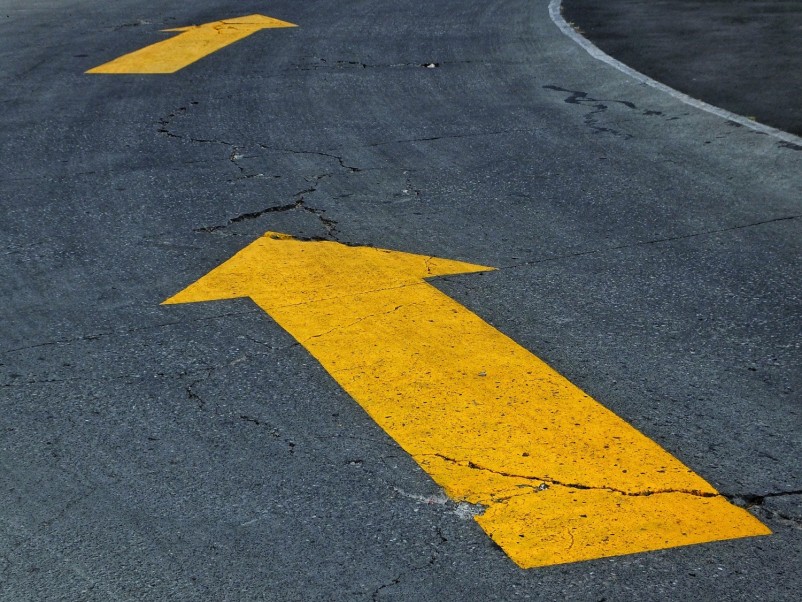
Traffic signs and signals, in general, are intended to manage the flow of highway traffic, thereby making it much safer for drivers, pedestrians, and bicyclists who use the roadways of our country. Most of these signs are put in place by state departments of transportation and other government agencies, in an effort to reduce confusion on the highway, and avoid as many traffic accidents as possible.
The messages which are conveyed by traffic signs and signals can either be spelled out with English words or they can use colors, shapes, and symbols so as to impart valuable information to drivers quickly. In order for anyone to obtain a driver's license in their respective state, it will be necessary to have an understanding of the traffic signs and signals which are used on the highways.
What Does a Yellow Arrow Street Sign Mean?
Yellow traffic signs are intended to alert drivers to hazards or certain road conditions that are in effect up ahead, thus preparing the driver to manage whatever situation is in effect. For instance, they are often used to alert drivers to the fact that a school zone lies ahead, and that you should begin to slow down in anticipation of increased pedestrian traffic in the area. There are many different types of traffic signs, which are colored yellow, for instance, a Slippery When Wet sign, which actually has no wording on it at all.
However, just by depicting an automobile with wavy lines behind it, the intent becomes clear, and any motorist should quickly recognize the fact that there might be a slippery road ahead. Of course, that same meaning doesn't apply when you have bright sunshine and dry conditions on the roads, but it is meant to alert you to the fact that when roads are wet, it's likely to be slippery up ahead. So the general purpose of yellow traffic signs is to provide a heads-up to a motorist that there could be changing traffic conditions up ahead, and that you should be prepared for it.
Other types of yellow signs
There is actually a whole catalog of yellow traffic signs which are currently in use in this country, and all of them are intended to be warning signs about some specific traffic condition. The most common shape for these yellow traffic signs is the square or rectangular shape, and it is displayed in a position where it rests on one of its four points, rather than on an entire edge.
When you see a yellow sign with a squiggly arrow pointing upwards, that means there is a winding road up ahead, and when you see a yellow sign with the 'T' symbol on it, that means there's an intersection up ahead, with only a left or right turn possible. A similar sign which has a symbol looking like a plus (+) sign, means that there's a crossroad ahead and that there are three other possible directions you can take at the intersection.
A sign with a straight line and a bar to the left-hand side indicates that there is a side road up ahead which goes off to the left, and the same kind of sign with the bar to the right indicates a side road going off to the right. When you see a sign that shows a truck symbol and a declining area which it's traveling on, you can be sure that there's a hill up ahead, and sometimes these signs will even depict the percentage of grade which that decline has.
When you see a sign with only a deer symbol leaping in the air, you can be sure that there are deer somewhere in the area, and that these have been known to cross the highway. A yellow sign with a cow depicted on it is intended to convey that a cattle crossing is up ahead and that you should be alert to that possibility. When you see a tractor being operated by a farmer on a yellow sign, that means there's a crossing up ahead where farm machinery typically goes from one side of the road to the other.
An arrow pointing straight ahead with a merging arc line off to the right means that traffic will be merging into your lane from the right-hand side, and of course, the same thing applies to the left side. One very common yellow sign shows a solid arrow going in both directions, and that's meant to alert you to the fact that there is two-way traffic up ahead.
You may also see a sign depicting a snowmobile and driver, and obviously, that means that there's a snowmobile crossing in the immediate area. You may see a triangular yellow sign which alerts you to the fact that there is no passing in the area up ahead and that you should stay in your present lane.
Finally, it's very common to see rectangular yellow signs which show the recommended speed for exiting or entering a ramp or for slowing down in general due to some traffic conditions up ahead.
Traffic Control Equipment
There are a number of manufacturers in the country that work with local agencies and governments to provide them with traffic control equipment, which can be used to help manage the flow of traffic, and to keep local roadways safe. Some of the traffic control equipment which is manufactured and made available to communities include traffic barricades, traffic cones, delineators, signposts, and mounting hardware, pre-printed traffic signs, traffic signals, arrow boards, speed gauges, and both permanent and temporary signs used for a variety of purposes.
One of the premier manufacturers in this country of such equipment is Work Safe Traffic Control Industries, Inc., and they offer a broad range of traffic control devices and essential equipment for managing traffic. Most of the traffic control devices are weatherproof and made of extremely sturdy material such as heavy-duty stainless steel so that they can withstand the effects of weathering and extreme conditions if necessary. In addition to yellow warning traffic signs, you'll find just about everything else you could possibly need to keep your community roadways safe at Work Safe TCI.
Final thoughts
All traffic signs and signals play an important role in making roadways safe for drivers, and in minimizing any kind of confusion which might develop on roadways. Yellow signs are especially important because they provide an advance warning of conditions that are in effect up ahead so that you, as a motorist, can prepare yourself for that prior to arriving at the location. Since there are so many possible yellow warning signs, it would be worth your while to take some time and study them, so you're aware of what most of them mean.
While it's possible that you won't run into all of the many different kinds of yellow warning signs which exist, it's important that you do know most of them so that you will be able to respond appropriately to whatever condition is in effect up ahead.
A little bit of preparation can make you a safer driver, and it's no exaggeration to say that it's even possible that knowing what certain signs mean could save your life someday.

 Share on Facebook
Share on Facebook





















